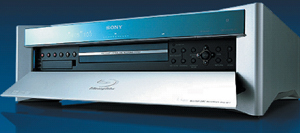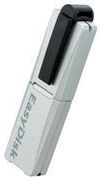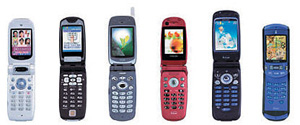The Pulse 2
Back to Contents of Issue: June 2003
|
|
|
|
|
|
 Sony's BDZ-S77 Blu-Ray Recorder It's a world's first, and it's set to change the DVD scene forever, folks. Please welcome the BDZ-S77 from Sony, the first ever released Blu-ray recorder! Blu-ray discs are the successor to DVD and the living proof that for every marketing professional you manage to bury 10 feet down in the Nevada desert (just a suggestion), another 100 will pop up and spring another gadget format on you. Just when everyone is being persuaded to surrender their old videotapes and convert to the heavenliness that is DVD, the marketing department of your average consumer electronics conglomerate ups and produces yet another new system you simply can't live without. But whether you welcome Blu-ray with open arms or view it as the next threat to the well-being of your pocketbook, the format is here to stay. Why? Because it's bigger (the Blu-ray discs are 23GB and the maximum capacity of the discs is said to be 27GB on one side), it's clearer (it can cope with high-definition images without compression losses) and it's faster, with a transfer rate of 36Mbps. The new format is backed by Matsushita, Philips, Sony, Hitachi, LG, Pioneer, Samsung, Sharp and Thomson, so resistance is clearly futile. The BDZ-S77 has a built-in BS Digital television tuner that lets the machine record two hours of programs in both 1080i and 720p and, if you're quick, you can snap one up in stores such as Yodobashi or Bic Camera in Shinjuku for under JPY400,000 yen (the manufacturer's suggested retail price is JPY450,000). More info: www.sony.jp/products/Consumer/BD/index.html NHJ's v@amp BA-500
The v@amp BA-500 records to its own internal 128MB of flash memory as well as to Smart Media cards. The player has a now-standard backlit LCD display, various music modes and the ability to display Japanese characters. It also has an FM radio/tuner and a built-in microphone so it can double as a voice recorder. You should get 30 hours of continuous play out of the battery, and since it connects to a computer via USB, the v@amp is compatible with all flavors of PC operating systems. In keeping with the name, the widget's black and silver casing gives it suitably vampish good looks. On the market since April, the v@amp sells for about JPY28,800. More info: www.nhjapan.com/
If you've been interested in getting yourself one of those so-called "USB keys" for a spot of hot-swapping memory lurve, but you think the price to pay for your digital promiscuity is a little too high, then it's time to embrace the "Easy Disk Cute" from IO Data. Starting at an extremely pocketbook-friendly JPY2,700 for the 32MB version, the Easy Disk Cute flash memory storage device is compatible with any computer with USB capabilities and carries its own email and synching software to optimize its portability. It comes in 32, 64, 128 and 256MB capacities and, in keeping with the cute moniker, is nattily designed and available in red, silver or black. More info: www.iodata.co.jp/news/200303/edc.htm Fuji's FinePix F700
The latest in a long line of very smart digital cameras, the FinePix F700 is the first to be operated by a host of miniature killer bees packed into its casing. At least, with Fuji calling it the "Super CCD Honeycomb IV SR," that's what it sounds like. In fact, the honeycomb thing is actually the fourth iteration of a photo-diode space-saving arrangement that allows more pixels to be crammed into the Super CCD. Even such a tiny body as the F700 has the technology to knock out 6.2 million effective pixels, producing images with a maximum resolution of 2,832 x 2,128. That is, in real money, pictures far larger than anyone really ever needs. The new camera also has a three-times optical zoom, all the manual and auto functions we've come to expect as standard and an extra wide body, which helps you keep a grip on things. More info: www.fujifilm.co.jp/fxf700info.html The New and Improved PlayStation 2
Sony may be guilty of making more revisions of its PlayStation 2 games console than the WWE has newly-crowned champions, but the SCPH-50000 is the company's first PS2 with a progressive-scan DVD player. Sony is clearly playing a spot of catch up with Microsoft's Xbox here, since the newer machine has been capable of playing in progressive scan from the very start, but it's still a welcome move, particularly for any of those games console owners who pay JPY25,000 for the dumb thing. But honestly, it's way more than just a marketing scheme peddled by the manufacturers, right? Again, bowing to consumer demand, the new PS2 can also handle playback of DVD-RW discs, although not DVD-RAM discs. Nevertheless, movie fans without a dedicated DVD player will be happy campers now, even if they do have to shell out again for the SCPH-10100 component or SCPH-10330 digital cable and then again for the SCPH-10420 remote control unit. The new remote has added functions, such as the ability to turn your console on and off, reset it or open the disc tray, but who thinks you should be paying again just for that? Nah, thought not. More info: www.scei.co.jp/corporate/release/pdf/030414.pdf
NTT DoCoMo's launch announcement and press conference for the 505i-series featured the next generation of the carrier's 2G i-mode terminals and one of Japan's cutest teenage idols. Among the six terminals (from Mitsubishi, Fujitsu, NEC, Panasonic, Sharp and Sony Ericsson), you'll find enhanced Java, mobile Flash display capability, enhanced onboard memory, removable memory sticks, a 1.3 megapixel camera, QVGA-resolution displays, fingerprint-scanning authentication and enhanced i-mode mail. My first impression was that NTT DoCoMo had now entered a "post-packet-fee" era. By this, I mean that the company is no longer merely fixated on deploying features and services that boost individual packet usage and ARPU; this has been the sine qua non of mobile carriers in this country since the dawn of i-mode. Now, with 1.3 megapixel cameras, extensive use of removable memory, a high-tech fingerprint reader/scanner built-in and other non-packet-generating features, DoCoMo has clearly decided to make the phones uber-sexy, so as to grab market share and stem the churn over to KDDI (and, to a lesser extent, J-Phone). Who cares how many packets 505i users generate so long as they actually buy one of these babies and make lots of voice calls, which are still the cash cow for DoCoMo. And you can take pretty decent snaps with it, too, even if you never send a single photo over the network. As Wireless Watch Japan video producer Lawrence Cosh-Ishii wryly pointed out, the contrast between this DoCoMo extravaganza and J-Phone's December 2002 3G launch couldn't have been starker. Then, the traditionally teen-market-focused J-Phone guys went out of their way to look, act and appear ultra-buttoned-down and uber-corporate -- in keeping with the business target audience of their new Vodafone Global roaming services. On the other hand, DoCoMo -- a historically plodding, corporate entity that regularly runs black and white snaps of its president in full-page newspaper ads touting the company's technology -- bent over backwards to emphasize the youth-centric appeal of the sexy new i-mode handset series. Takeshi Natsuno, co-creator of i-mode, was on stage wearing a cream-colored suit with no tie, while the firm must have written an I-don't-know-how-big check to get the (apparent) keitai fan Kato to try out the new models firsthand; she appeared surprised to find camera-quality digital photo capabilities in the new phones. Maybe teen idols don't get to Akihabara much? Big D has recently rolled out a watch-phone that runs on the PHS network, a GPS-enabled handset (its first consumer mass-market device so enabled) and an e-commerce payment system that uses the infrared port for point-of-sale terminal communications. Whew! During the 505i launch event, Natsuno was on stage to demonstrate the F505i's capabilities -- including the fingerprint reader used to authenticate access to the phone's address book, mail, picture store and scheduler. When Natsuno applied his finger onto the reader plate glass (located at the bottom of the phone), nothing happened! "OK, we'll try that later," he said somewhat sheepishly, after waiting for some 30 seconds. Now to be fair, the phones on demo were all pre-production models and the company said it will still take up to three months to get them ready to hit the market; presumably, any interface flaws will be solved by then. But on the other hand, they wouldn't have tried to demo the fingerprint reader if they hadn't thought it was ready for prime time. Early adopters: Be forewarned. -- Daniel Scuka
NTT DoCoMo 505i-series Launch Announcement and Specs |
|
Note: The function "email this page" is currently not supported for this page.


 The "Easy Disk Cute" EDC-32M and Friends
The "Easy Disk Cute" EDC-32M and Friends





